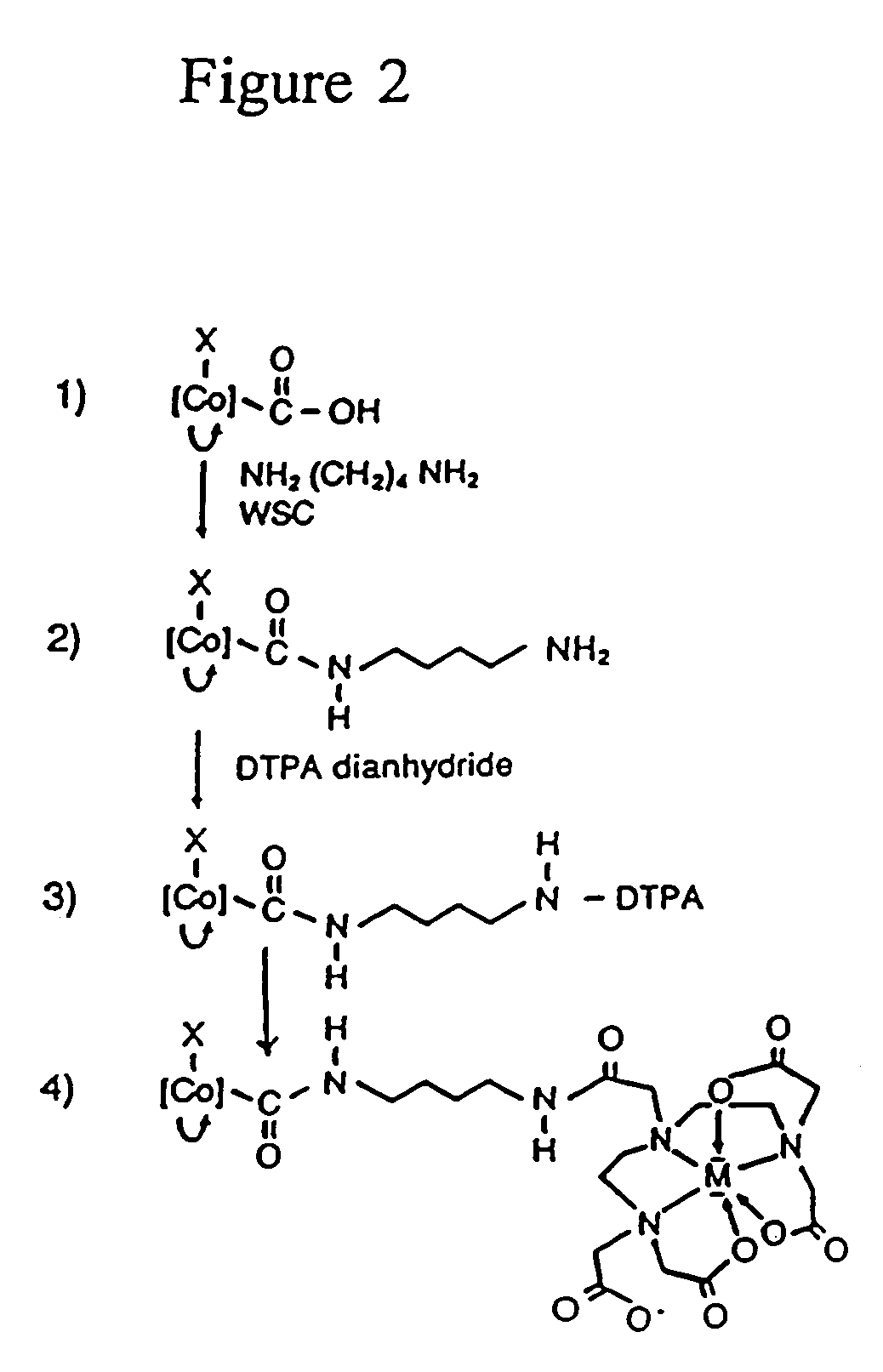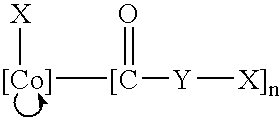Radionuclide labeling of vitamin B12 and coenzymes thereof
a technology of radionuclide and vitamin b, which is applied in the direction of group 3/13 element organic compounds, drug compositions, and therapy, etc., can solve the problems of half life of 270.9 days, co-57-cyanocobalamin unsuitable for clinical tumor imaging, and failure to chemically insert other metal ions into cobalt free corrinoid rings
- Summary
- Abstract
- Description
- Claims
- Application Information
AI Technical Summary
Benefits of technology
Problems solved by technology
Method used
Image
Examples
example 1
Cyanocobalamin-b-(4-aminobutyl)amide
[0035]A mixture containing cyanocobalamin-b-carboxylic acid (1.0 g, 0.6 mmol), hydroxybenzotriazole (0.81 g, 6 mmol) and 1,4-diaminobutane dihydrochloride (4.8 g, 30 mmol) in 100 ml of water was adjusted to pH 7.8. 1-Ethyl-3-(3′-dimethylaminopropyl)carbodiimide (1.26 g, 6.6 mmol) was then added, the pH was adjusted to 6.4 and the reaction stirred at room temperature for 24 h. TLC on silica gel using n-butanol-acetic acid water (5:2:3) showed the reaction to be complete. Cyanocobalamin-b-(4-aminobutyl)amide was extracted into 92% aqueous phenol and the phenol layer was washed several times with equal volumes of water. To the phenol extract were added 3 volumes of diethylether and 1 volume of acetone. The desired cobalamin was removed from the organic phase by several extractions with water. The combined aqueous layers were extracted three times with diethylether to remove residual phenol, concentrated to approximately 20 ml in vacuo and crystallize...
example 2
Cyanocobalamin-b-(4-aminobutyl)amide DTPA
[0036]Cyanocobalamin-b-(4-aminobutyl) amide (500 mg), 0.3 mmol) was dissolved in 30 ml sat. sodium bicarbonate and treated with solid DTPA dianhydride (1.2 g, 3.4 mmol). The progress of the reaction was monitored by TLC on PEI plates using n-butanol-acetic acid-water (5:2:3) as the solvent. After 30 min incubation at room temperature a second 1.2 g of the dianhydride was added. After two additional additions of dianhydride with adjustments of the pH to 8.2 the reaction mixture was incubated overnight. Cyanocobalamin-DPTA adduct was then extracted into 92% aqueous phenol and purified as described above. The preparation was evaporated to dryness in vacuo and isolated as a glass. Yield 460 mg, 77%. The cyanobalamin-DTPA adduct behaves as a polyanion on paper electrophoresis in 0.1 M sodium phosphate buffer pH 7.1.
example 3
Methylcobalamin-b-(4-aminobutyl)amide
[0037]Methylcobalamin-b-carboxylic acid (1.0 g, 0.6 mmol) was reacted with diaminobutane dihydrochloride as described above for the cyano derivative. The cobalamin was purified by extraction through phenol (see above) and the resulting aqueous solution was concentrated in vacuo. This solution was chromatographed on AG1-X2 200–400 mesh in the acetate form (20×2.5 cm) and the pass through collected. The pass through was concentrated to approximately 20 ml and the desired cobalamin crystallized from aqueous acetone. Yield 920 mg, 88%. Unreacted methylcobalamin-b-carboxyclic acid was eluted with 1 M acetic acid, concentrated and crystallized from aqueous acetone. Yield 60 mg, 6%.
PUM
| Property | Measurement | Unit |
|---|---|---|
| half life | aaaaa | aaaaa |
| energy | aaaaa | aaaaa |
| energy | aaaaa | aaaaa |
Abstract
Description
Claims
Application Information
 Login to View More
Login to View More - R&D
- Intellectual Property
- Life Sciences
- Materials
- Tech Scout
- Unparalleled Data Quality
- Higher Quality Content
- 60% Fewer Hallucinations
Browse by: Latest US Patents, China's latest patents, Technical Efficacy Thesaurus, Application Domain, Technology Topic, Popular Technical Reports.
© 2025 PatSnap. All rights reserved.Legal|Privacy policy|Modern Slavery Act Transparency Statement|Sitemap|About US| Contact US: help@patsnap.com



